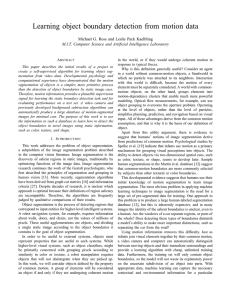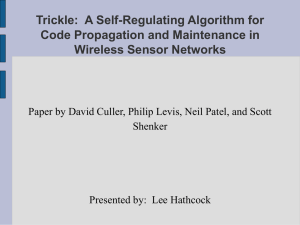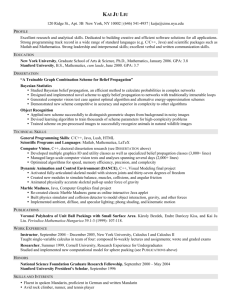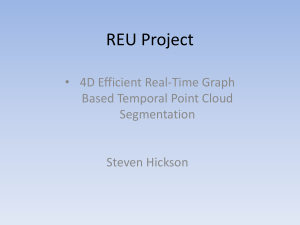Learning object boundary detection from motion data M.I.T. Artificial Intelligence Lab
advertisement
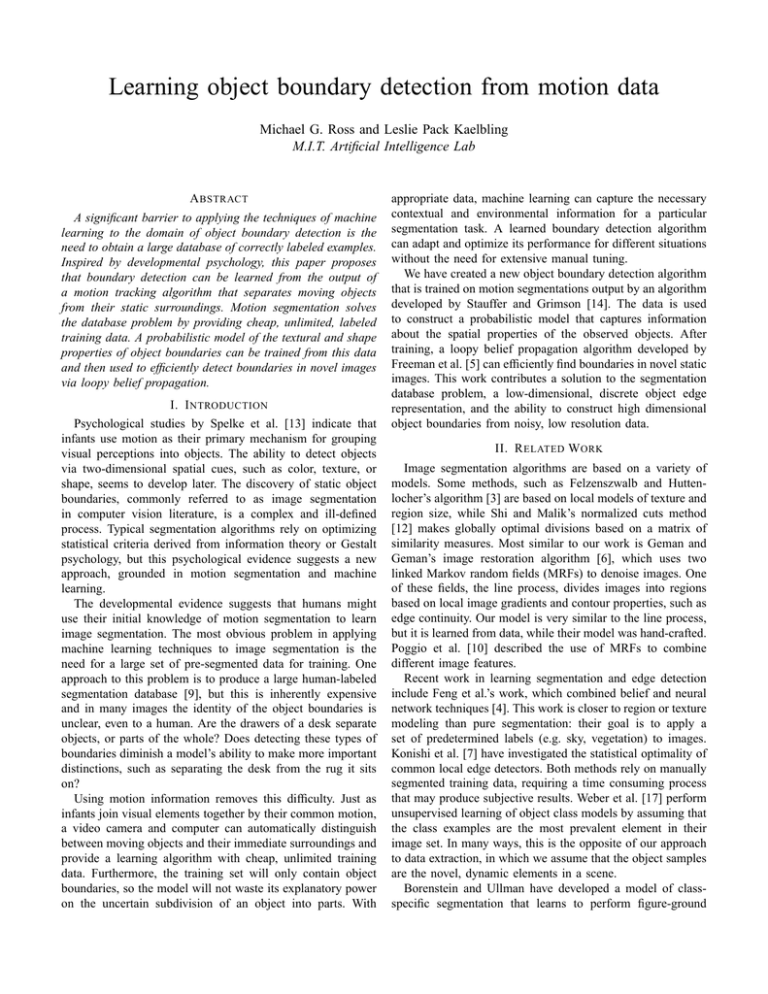
Learning object boundary detection from motion data
Michael G. Ross and Leslie Pack Kaelbling
M.I.T. Artificial Intelligence Lab
A BSTRACT
A significant barrier to applying the techniques of machine
learning to the domain of object boundary detection is the
need to obtain a large database of correctly labeled examples.
Inspired by developmental psychology, this paper proposes
that boundary detection can be learned from the output of
a motion tracking algorithm that separates moving objects
from their static surroundings. Motion segmentation solves
the database problem by providing cheap, unlimited, labeled
training data. A probabilistic model of the textural and shape
properties of object boundaries can be trained from this data
and then used to efficiently detect boundaries in novel images
via loopy belief propagation.
I. I NTRODUCTION
Psychological studies by Spelke et al. [13] indicate that
infants use motion as their primary mechanism for grouping
visual perceptions into objects. The ability to detect objects
via two-dimensional spatial cues, such as color, texture, or
shape, seems to develop later. The discovery of static object
boundaries, commonly referred to as image segmentation
in computer vision literature, is a complex and ill-defined
process. Typical segmentation algorithms rely on optimizing
statistical criteria derived from information theory or Gestalt
psychology, but this psychological evidence suggests a new
approach, grounded in motion segmentation and machine
learning.
The developmental evidence suggests that humans might
use their initial knowledge of motion segmentation to learn
image segmentation. The most obvious problem in applying
machine learning techniques to image segmentation is the
need for a large set of pre-segmented data for training. One
approach to this problem is to produce a large human-labeled
segmentation database [9], but this is inherently expensive
and in many images the identity of the object boundaries is
unclear, even to a human. Are the drawers of a desk separate
objects, or parts of the whole? Does detecting these types of
boundaries diminish a model’s ability to make more important
distinctions, such as separating the desk from the rug it sits
on?
Using motion information removes this difficulty. Just as
infants join visual elements together by their common motion,
a video camera and computer can automatically distinguish
between moving objects and their immediate surroundings and
provide a learning algorithm with cheap, unlimited training
data. Furthermore, the training set will only contain object
boundaries, so the model will not waste its explanatory power
on the uncertain subdivision of an object into parts. With
appropriate data, machine learning can capture the necessary
contextual and environmental information for a particular
segmentation task. A learned boundary detection algorithm
can adapt and optimize its performance for different situations
without the need for extensive manual tuning.
We have created a new object boundary detection algorithm
that is trained on motion segmentations output by an algorithm
developed by Stauffer and Grimson [14]. The data is used
to construct a probabilistic model that captures information
about the spatial properties of the observed objects. After
training, a loopy belief propagation algorithm developed by
Freeman et al. [5] can efficiently find boundaries in novel static
images. This work contributes a solution to the segmentation
database problem, a low-dimensional, discrete object edge
representation, and the ability to construct high dimensional
object boundaries from noisy, low resolution data.
II. R ELATED W ORK
Image segmentation algorithms are based on a variety of
models. Some methods, such as Felzenszwalb and Huttenlocher’s algorithm [3] are based on local models of texture and
region size, while Shi and Malik’s normalized cuts method
[12] makes globally optimal divisions based on a matrix of
similarity measures. Most similar to our work is Geman and
Geman’s image restoration algorithm [6], which uses two
linked Markov random fields (MRFs) to denoise images. One
of these fields, the line process, divides images into regions
based on local image gradients and contour properties, such as
edge continuity. Our model is very similar to the line process,
but it is learned from data, while their model was hand-crafted.
Poggio et al. [10] described the use of MRFs to combine
different image features.
Recent work in learning segmentation and edge detection
include Feng et al.’s work, which combined belief and neural
network techniques [4]. This work is closer to region or texture
modeling than pure segmentation: their goal is to apply a
set of predetermined labels (e.g. sky, vegetation) to images.
Konishi et al. [7] have investigated the statistical optimality of
common local edge detectors. Both methods rely on manually
segmented training data, requiring a time consuming process
that may produce subjective results. Weber et al. [17] perform
unsupervised learning of object class models by assuming that
the class examples are the most prevalent element in their
image set. In many ways, this is the opposite of our approach
to data extraction, in which we assume that the object samples
are the novel, dynamic elements in a scene.
Borenstein and Ullman have developed a model of classspecific segmentation that learns to perform figure-ground
segmentations for a particular class of objects by building a
database of fragments that can be assembled like puzzle pieces
[1]. They hypothesize that motion could be a source of training
data for their algorithm, which combines segmentation and
classification.
The use of belief propagation to detect and reinforce image
contours is very similar to the work of Shashua and Ullman
[11], which described a hand-built saliency network that
combined incomplete contours to minimize an error function.
(s̄, ē) to the nodes is
Pr(s̄, ē) = Z −1
Y
φ(si , ei )
i
Z=
XY
s̄0 ,ē0
Y
ψr(i,j) (ei , ej )
(1)
ψr(i,j) (e0i , e0j ).
(2)
N
φ(s0i , e0i )
i
Y
N
Z is the partition function, which normalizes the probability,
but whose computation is intractable for all but the smallest
examples.
III. O BJECT B OUNDARY M ODEL
Our object boundary model is inspired by Freeman et
al.’s work on learning super-resolution [5]. We model the
object edges as an MRF with two sets of variables: the
visible “signal” nodes representing image data, and the hidden
“scene” nodes that represent the underlying object edges. In
the following description, the possibility that no edge is present
at a location is included among the set of edge scenes.
Entry
Exit
Y
a (e
ab
ov
e ,e
i)
eabove
Yl(eleft, ei)
ei
Yr(eright, ei)
s
edge
Y
b (e
be
lo
w ,e
i)
eleft
above
Inflection
eright
F(si,ei)
sleft
e
sright
below
si
image
(signal)
sbelow
Fig. 1. Each edge node in our Markov random field is attached to a visible
data input node and to the edge nodes for neighboring image locations.
The MRF model (Figure 1) posits that the probability
of an edge assignment ei at location i is dependent on its
compatibility with the local image data si (φ(si , ei )) and its
compatibility with the assignments to the neighboring scene
nodes (ψl (eleft , ei ), ψr (eright , ei ), etc.). The value of an edge
node represents a 5 pixel by 5 pixel segment of an object
boundary (or the absence of a boundary) at a particular image
location. Its associated signal node represents the value of the
convolution of several image filters at that location. The image
areas covered by neighboring nodes are adjacent, but nonoverlapping.
If N is the set of neighbors (i, j), and r(i, j) is their
neighboring relationship, the joint probability of an assignment
Fig. 2. The edge scene values are represented by three parameters. Each
edge enters a scene patch at some border pixel, may change direction at an
inflection point, and exits at another border pixel.
In the general case, there is no known closed-form solution for specifying the compatibility functions associated
with particular marginal probabilities in an MRF. Iterative
proportional fitting (IPF) is a gradient descent method that
repeatedly adjusts compatibility functions to match the network’s marginal probabilities to match an empirically observed
set. Unfortunately, IPF requires us to perform inference on
the MRF after each descent, which is prohibitively expensive.
Instead, we can substitute belief propagation for the exact
inference step. An analysis of the resulting algorithm in the
context of Wainwright’s tree reparameterization [16] view of
belief propagation reveals that it has a simple fixed point[15].
For an edge node i with signal node is and neighbors n =
l, r, a, b:
φ(s, e) = Pr(is = s, i = e)
and
ψn (en , e) =
Pr(n = en , i = e)
.
Pr(n = en ) Pr(i = e)
These compatibility settings are intuitively sound because they
give high compatibilities to pairs that co-occur frequently,
and they exactly correspond to Freeman et al.’s conditional
probability message passing algorithm [5].
In Section IV, we will demonstrate that it is easy to
generate training data, so it is a simple matter to estimate any
discrete probability function by frequency counting. Therefore,
we discretize filter responses by counting them in 1000-bin
histograms. The set of potential edges is already discrete, but it
is too large to handle via simple counting. A 5x5 binary image
can take on 225 possible values. Even if we discard images that
could never represent an edge fragment, such as an all-white
image, noise and natural variability still leaves us with tens
of thousands of edge images. Therefore, we have developed a
simple edge parameterization (Figure 2) that reduces the space
to 2717 possible edges and provides excellent coverage of the
examples in our training set. Each edge is represented by the
boundary pixel at which it enters the 5x5 patch, a possible
interior inflection point, and a patch boundary exit point. The
“empty” edge, representing the absence of a boundary, is
included as a special case. During training, each scene value
is represented by its best-fit parameterized edge.
IV. T RAINING A LGORITHM
Just as simple neurons can detect motion due to their
tendency to habituate to static input, computer algorithms
can detect motion by background subtraction. By modeling
the values observed at every image location across a video
sequence, areas containing moving objects are highlighted
as outliers. In this work we used Stauffer and Grimson’s
background subtraction algorithm [14], which models every
image pixel with a small set of Gaussian distributions. This
algorithm is easy to compute and is robust to non-motion
changes, such as lighting variations, that we wish to discard.
The background subtracter works on a stream of images; for
each image it returns a binary image that labels every pixel as
either foreground (moving) or background (static) (Figure 3).
Fig. 3. Top row: The background subtraction algorithm learns the background
colors at each pixel and returns a binary image indicating the location of the
moving object. Bottom row: The moving object is cropped out of the image
and the binary image is processed to produce the object edge image.
Motion can only give us data about the object edges immediately around the moving object. Therefore, we disregard all
of the original image and the binary foreground-background
image, except the areas containing the moving object and
its immediate surroundings. Given the cropped foregroundbackground image, we scan across all rows and columns
and label every location at which there is a transition from
foreground pixels to background pixels as an edge. The output
is a new binary image of edge and non-edge pixels. Our goal
is to learn a model that will generate an equivalent object edge
image from a novel, static image. Each image and edge image
pair provide a complete set of assignments for an MRF object
boundary model of the image.
During training, we need to construct representations of the
φ and ψ functions. We will do this by learning three sets of
probability distribution functions from the training data, which
can be used to compute the compatibility values described in
Section III using Bayes’ rule and marginalization. The edge
pixels at any location are represented by their best-fit edge
in the parameterized edge model (Figure 2). Learning Pr(e),
Pr(s|e), and the conditional probability functions Pr(en |e)
for each neighboring relation (above, below, left, right) will
provide the necessary information. All the probabilities are
discrete, and data is plentiful, so it is possible to learn them
by storing the value frequencies.
The algorithm must combine the data from multiple filters
into a single Pr(s|e) value. Experience shows that no single
filter will be an adequate edge detector. In some simple
images, local horizontal and vertical image gradients respond
strongly to object boundaries, but in highly textured examples they might respond more strongly to non-edge regions.
One solution is to probabilistically combine many features.
The underlying signal for each scene is an n-tuple of the
values of a set of filters at a particular location. We need to
represent the joint probability distribution Pr(s1 , s2 , . . . , sn |e)
for each possible edge. Incorporating more features requires
exponentially more data to estimate, and memory to store,
the resulting model. Therefore, we make the naive Bayes
assumption that the features are conditionally independent
given the underlying edge and approximate the joint likelihood
as Pr(s1 |e)·Pr(s2 |e)·. . .·Pr(sn |e). This assumption is clearly
incorrect, but the results it gives are still useful in practice. In
the future, we hope to employ new representations that will
better approximate the full joint probability of the features.
Konishi et al. [8] have discovered an adaptive histogramming
algorithm that efficiently combines edge detection features.
If the training data were noiseless, from a perfect background subtraction algorithm, the learning algorithm would
only experience closed contours, and for any neighboring
pair of candidate edges whose endpoints did not match the
compatibility ψn (en , e) would be zero. Unfortunately, this is
not the case, so we encourage the formation of closed contours during inference by setting the compatibilities for nonmatching neighbors to be nearly zero. Setting the compatibilities to exactly zero would violate the MRF definition, which
forbids zero probability states. This produces cleaner contours
and fewer spurious edges, but does not completely rule out
incomplete contours, because our edge parameterization does
not allow multiple contours to combine via T-junctions.
V. I NFERENCE A LGORITHM
There is no known efficient algorithm for exact inference on
a Markov random field, so we employ the belief propagation
algorithm, a speedy approximation that works well in practice.
Once the model is trained, belief propagation can compute
an approximate maximum a posteriori (MAP) estimate of
the object edges present in a static scene. Belief propagation
produces exact MAP estimates in loopless MRFs [19][18]. Our
network has loops, but belief propagation still works well in
practice [5].
The belief propagation algorithm, as described by Freeman
et al., begins by selecting a set of locally likely candidate
edges at each location. In our implementation, we first visit
each edge node i and select the empty edge and the N − 1
edges (where we have experimented with 20 < N < 100)
with the largest Pr(si , ei ). Because the edge candidates at a
node have only been selected based on local information, it is
possible that the node may have no assignments compatible
with some of the potential values of its neighbors. Therefore,
we visit each node a second time, and add additional scenes
so that the node can continue any edge that enters and exits
it from its neighbors.
On every iteration of the algorithm, every node is visited
and its messages are updated. A node i can be described by
the signal associated with it (si ), a set of candidate scenes
(Ei ), a set of neighbors (Ni ), and an array of messages from
each neighbor indexed by scene (mi←j , j ∈ Ni ). All messages
are initialized to 1. The index r(i, j) indicates the position of
j relative to i (left, right, above, below). On every iteration,
we simultaneously update the messages at each node by the
following equation:
mi←j (e ∈ Ei ) =
max φ(sj , ej )ψr(i,j) (ej , e)
ej ∈Ej
Y
mj←k (ej ). (3)
k∈{Nj \i}
Each message mi←j (e) represents the compatibility between
node i having assignment e and the information from its
neighboring node j. The message is updated by maximizing
a function over the neighboring assignments which combines
their fit to the local data at j and their match to information
from the other neighbors of j. After sufficient propagation
(convergence is not guaranteed in loopy networks), we can
approximate the MAP estimate for the MRF by computing
Y
mi←j (e)
(4)
MAPi = arg max φ(si , e)
e∈Ei
j∈Ni
at each node i. This selects the edge e that is maximally
compatible with local evidence and the information propagated
from the remainder of the graph.
Fig. 4. Top: MAP estimates after 0, 5, and 10 iterations on a sample disc
image. Bottom: MAP estimates after 0, 10 and 20 iterations on a sample robot
image.
VI. R ESULTS
We trained models on three video sequences: a dark disc
moving against a white background, a toy robot traveling
across a highly textured carpet, and cars driving along a
highway. The first two sequences contained approximately
1200 frames, and the third sequence contained 7000 frames.
In each case the first 200 frames were used to initialize the
background subtraction algorithm and were not included in
the training set. The detection results presented are all drawn
from these discarded video frames or from other non-training
sets.
Different numbers of candidate scenes and iterations were
required for each result, depending on the complexity of the
object and the quality underlying data. Because we select an
initial set of N possible values at each edge node, and then
augment them with extra possibilities to allow for contour
completion, each node in a particular MRF may consider a
different number of possible edges. Disc results used N=20
candidates and 10 belief propagation iterations. The robot
results used 100 candidates and 20 iterations, due to the robot’s
irregular shape and the “noise” provided by the textured carpet.
The cars required 40 candidates and 20 iterations.
Although we have experimented with texture-sensitive filters, such as Gabor functions, all of the results presented here
were computed using four local gradient operators, oriented to
0, 45, 90, and 135 degrees, as the input signals. These filters
were computed on the grayscale image values; color was not
used. We trained a four-neighbor model in which each node
is connected to its first-order (above, below, left, and right)
neighbors.
In a typical run, the initial MAP estimate, made before belief
propagation occurs, contains approximate object edges, which
are improved by enforcing local edge continuity and learned
shape information. Figure 4 demonstrates the progress of belief
propagation on samples from the disc and robot sequences.
Figure 5 displays a sample result from each trained model.
Unsurprisingly, the simple disc case was the most successful,
due to its highly regular shape and the strong spatial derivatives
along its boundaries. The robot was the most difficult, given its
irregular shape and the fact that the carpet produced spurious
image gradients that the model had to learn to ignore. The
Fig. 5. Sample results from three different data sets. Each row shows, from left to right, an image outside the training set, the contrast-enhanced outputs
of the four coarse derivative filters, and the result of using our MRF model and belief propagation to find object edges in the scene. The disc border was
detected with approximately 20 candidates per location and 10 rounds of belief propagation. The robot required approximately 100 candidates per location
and 20 rounds, and the car used 40 candidates and 20 rounds.
car was very successful, especially considering that the car
shadows were included as moving objects during training. The
model segmented the car and its shadow from the road, and
also detected other object and non-object edges in the image.
In both the car and robot examples, non-object edges,
such as the lines on the road and internal color changes
on the robot, were detected. In the robot, these extra edges
apparently prevented some of the robot object contours from
closing properly. Because our edge model only allows one
entry and one exit point in each patch, it is impossible to
represent contour intersections properly. This clearly needs
to be addressed in the future. In the case of the car output,
a more sophisticated model of shape would be necessary to
eliminate the road lines as potential objects, if we desired to
do so. It is generally accepted, however, that some degree of
oversegmentation is preferable to undersegmentation.
In all three cases, it is important to note that the contours
were detected remarkably well given the sparse, imperfect
information that was available. Next to each image in Figure
5 is the four input signals used to produce the object edge
outputs. Gradients were only computed at the image locations
associated with the center of each edge node’s patch, so
an image of height h and width w is represented only by
hw
25 inputs in each filtered image, and these filters were
then combined suboptimally by the naive Bayes assumption.
The shape model that inter-relates neighboring edge patterns
provides much of the output accuracy.
Fig. 6. From left to right: boundary detection with our algorithm, with the
default Canny edge detector, and with a hand-tuned Canny edge detector.
Figure 6 compares our performance on the robot image to
the output of the Canny edge detector [2] included in the
Matlab Image Toolbox. Our detector significantly outperforms
the results using the default threshold and smoothing settings,
and approaches the output of the Canny detector with manually
chosen parameters (threshold = 1, sigma = 0.2). Our algorithm
has learned many of the boundary rules that are hand-coded
into the Canny algorithm, and is able to adapt itself to the
requirements of the visual environment without the need for
manual parameter tuning. The Canny algorithm also has the
advantage of higher resolution gradient information than that
available to our algorithm.
Figure 7 demonstrates that the model trained on the car
data sequence can be successfully applied to other similar
situations. The images in this test set come from another
road which was observed in the same wide-angle video as
the training data. The model does a good job at detecting
the car boundaries. The errors arise from extremely low
image gradients at the borders of some of the cars, and the
incompatibilities caused by the intersection of car and road
contours.
Fig. 8. Results of running the robot model on a disc image, and vice-versa.
Although the MRF model is very simple, it is clear that it
learns a great deal of contextual information during training.
Figure 8 demonstrates the results of applying the disc-trained
model to a sample from the robot sequence and the robot
model to a disc image. In the first case, the disc model
erroneously detects a number of long contours along the
carpet. In the disc training sequence, nearly all the image
gradients were associated with object edges, so the model does
not know to avoid the weak, random carpet gradients. On the
other hand, the robot model appears to detect the boundaries
of the disc adequately, but it lacks the shape experience to
complete the simple circular contour.
The algorithm is very efficient, completing all the calculations for 20 iterations of belief propagation on a 150x150
pixel image with 40 candidates at each location in less than
30 seconds on a dual 1.4 GHz Pentium 3 machine in our
Java implementation. This is due to the efficiency of belief
propagation, the preselection of a small set of potential scenes
at each edge node, and the relatively large size of the edge
patches, which allow us to cover the image with only 900
edge nodes.
VII. F UTURE W ORK
Our future work will focus on improving the approximations in our model and in capturing more shape and feature
information. A clear area for improvement is the use of
the conditional independence assumption in computing the
scene likelihood function. Our experience with larger, more
complex feature sets suggests that their distributions are not
well approximated by this assumption and will require better
modeling techniques.
We also need to capture more information about the shapes
of objects in the training set and expand the features used
to detect potential edges. It is common to acquire shape
information with a multiresolution model, but our experiments
indicate that these models do not provide better results than
uniresolution models in belief propagation. We need to explore other methods of capturing and enforcing high-level
boundary properties, such as closed contours and global shape.
Expanding our feature set to include color and texture-sensitive
features such as Gabor filters should also help to improve our
results.
ACKNOWLEDGMENTS
This research was supported by the Singapore-MIT Alliance, the National Science Foundation, and the Office of
Naval Research.
The authors thank Bill Freeman for continuing input and
assistance in this research. They also wish to especially thank
Yair Weiss and Martin Wainwright for discussions about belief
propagation, Chris Stauffer for his background subtraction
software and the cars data set, Kinh Tieu for suggestions about
shape modeling, and Kevin Murphy for comments on the draft.
Finally, we thank Huizhen Yu, Erik Miller, John Winn, and
John Fisher for many discussions.
R EFERENCES
[1] E. Borenstein and S. Ullman. Class-specific, top-down segmentation. In
European Conference on Computer Vision, 2002.
[2] J. Canny. A computational approach to edge detection. IEEE Transactions on Pattern Analysis and Machine Intelligence, 8(6), November
1986.
[3] P. Felzenszwalb and D. Huttenlocher. Efficiently computing a good
segmentation. In DARPA Image Understanding Workshop, 1998.
[4] X. Feng, C.K.I. Williams, and S.N. Felderhof. Combining belief networks and neural networks for scene segmentation. IEEE Transactions
on Pattern Analysis and Machine Intelligence, 24(4), 2002.
[5] W.T. Freeman, E.C. Pasztor, and O.T. Carmichael. Learning low-level
vision. International Journal of Computer Vision, 40(1), 2000.
[6] S. Geman and D. Geman. Stochastic relaxation, gibbs distributions,
and the bayesian restoration of images. IEEE Transactions on Pattern
Analysis and Machine Intelligence, 6(6), November 1984.
[7] S.M. Konishi, J.M. Coughlan, A.L. Yuille, and S.C. Zhu. Fundamental
bounds on edge detection: An information theoretic evaluation of
different edge cues. In Computer Vision and Pattern Recognition, 1999.
[8] S.M. Konishi, A.L. Yuille, J.M. Coughlan, and Song Chun Zhu. Statistical edge detection: Learning and evaluating edge cues. IEEE
Transactions on Pattern Analysis and Machine Intelligence, In Press,
2002.
[9] D. Martin, C. Fowlkes, D. Tal, and J. Malik. A database of human
segmented natural images and its application to evaluating segmentation algorithms and measuring ecological statistics. In International
Conference on Computer Vision, 2001.
[10] T. Poggio, E.B. Gamble, and J.J. Little. Parallel integration of vision
modules. Science, 242, 1988.
[11] A. Shashua and S. Ullman. Structural saliency: The detection of globally
salient structures using a locally connected network. In International
Conference on Computer Vision, 1988.
[12] J. Shi and J. Malik. Normalized cuts and image segmentation. In
Computer Vision and Pattern Recognition, June 1997.
Fig. 7. These results were inferred by the car model on images drawn from another road’s traffic. The results required 40 candidates per node and 20
iterations of belief propagation. The model does a good job of extracting the car boundaries, except where the car colors blend into the road too much, or
where there is competition between car contours and strong road contours.
[13] E.S. Spelke, P. Vishton, and C. von Hofsten. Object perception, objectdirected action, and physical knowledge in infancy. In The Cognitive
Neurosciences, pages 165–179. The MIT Press, 1994.
[14] C. Stauffer and W.E.L. Grimson. Adaptive background mixture models
for real-time tracking. In Computer Vision and Pattern Recognition,
1999.
[15] M.J. Wainwright. Personal communication, 2002.
[16] M.J. Wainwright, T. Jaakkola, and A.S. Willsky. Tree-based reparameterization for approximate estimation on loopy graphs. In Neural
Information Processing Systems, 2001.
[17] M. Weber, M. Welling, and P. Perona. Unsupervised learning of models
for recognition. In European Conference on Computer Vision, 2000.
[18] Y. Weiss. Belief propagation and revision in networks with loops. Technical Report 1616, MIT Artificial Intelligence Laboratory, November
1997.
[19] Y. Weiss. Interpreting images by propagating bayesian beliefs. In
Advances in Neural Information Processing Systems, 1997.
